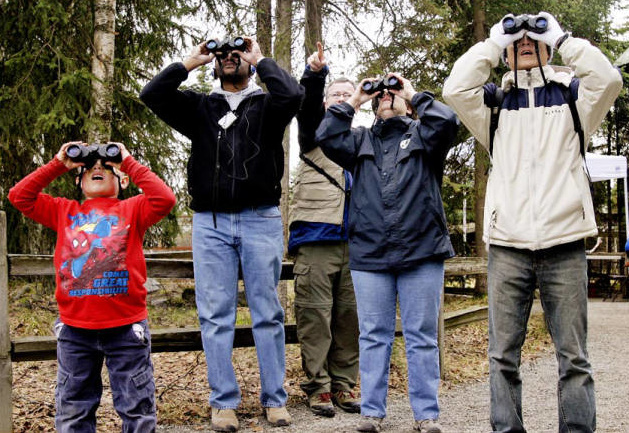 image courtesy of US Fish and Wildlife Service
image courtesy of US Fish and Wildlife Service
Nearly always savvy naturalists carry binoculars when afield, because you just never know when something amazing will pop up. We humans are stuck between two fabulously interesting worlds -- the tiny, up-close world we get a better view of with our hand lenses, and another too-far-away-to-see-well world, for which we need binoculars. Binoculars are especially great for viewing birds.
WHICH BINOCULARS TO GET?
Toy binoculars are no good for our purposes. They magnify images but distort the images so badly that the fine details we must see are lost.
Nowadays small, lightweight "traveler's binoculars" are popular, and you'll know why if you've ever lugged around a large, heavy pair for long. Such small binoculars, however, aren't necessarily the best for beginners.
The problem is that small binoculars, as well as strong telescopes, tend to have a narrow field of vision; it's like looking through a pea shooter. Telescopes are good, however, in the special case of looking at seabirds and ducks far from shore, and astronomical objects.
HOW POWERFUL?
 image courtesy of 'Halfblue' & Wikipedia Commons
image courtesy of 'Halfblue' & Wikipedia CommonsJust about every pair of decent binoculars has numbers stamped on its back -- two numbers separated by an x, such as 7 x 50, or 10 x 42. The number to the x's left tells how many times images are magnified. Therefore, binoculars stamped 7 x 25 magnify seven times. The larger the number, the more powerful the binoculars.
The best general-purpose birding binoculars are not the most powerful ones. That's because the greater the magnification, the less the thing you're looking at fits into your binoculars' field of vision. Also, the greater the magnification, the more unsteady hands make the images jiggle.
 image courtesy of John in Manchester, UK & Wikipedia Commons
image courtesy of John in Manchester, UK & Wikipedia CommonsFor birders, binoculars with seven to ten power are about right. If you're a practiced spotter and your hands don't shake, you might prefer ten to fifteen power.
The number on the right of the binoculars' x tells how large the big lenses, or objective lenses, are. In 7 x 35 binoculars, for example, they're thirty-five millimeters in diameter. The larger the number, the wider the lenses, thus the more light that enters into the binoculars, and the brighter the images appear. However, the larger the lenses, the heavier the binoculars are, too. For most birders, 8 x 40's are about right. If you're well practiced finding what you're trying to look at and have a steady hand, 10 x 40s are great. If these are too heavy, 8 x 30s are OK.
USING YOUR BINOCULARS
 image courtesy of New York Metropolitan Museum of Art, The Jefferson R. Burdick Collection, & Wikipedia Commons
image courtesy of New York Metropolitan Museum of Art, The Jefferson R. Burdick Collection, & Wikipedia CommonsParticulary when standing, our hands can't hold binoculars without shaking, at least a little. This causes the images to dance. Therefore, when standing while using binoculars, plant your feet firmly and somewhat spread apart, as the Colonel at the left is doing in an image from 1888.
The Colonel also knows to keep his arms close to his chest -- not spread like wings -- with the elbows somewhat beneath the binoculars. One's forearms should be firmly planted on the chest like columns rising vertically to support the binoculars. This is both more stable and much less tiring than holding binoculars with the arms spread.
Sometimes, as during a strong wind, you may need to lean against a tree, or plant your elbows on a boulder, or even lie on your belly with your elbows on the ground.
MASTERING YOUR TECHNIQUE
Here are three ideas for mastering your binoculars:
- When you bring the binoculars up to your eyes, keep looking exactly at the thing you want to see better. Let the binoculars unobtrusively slip between your eyes and the object.
- If you're having a problem, analyze what's going on. Maybe you always end up seeing too far to the right of your subject, or too high. If so, compensate by consciously aiming a little too far in the opposite direction. Always strive to do better than the last time.
- Practice, practice, practice! Aiming binoculars is very much like shooting a pistol from the hip: The more you practice, the more frequently you'll spot your quarry "the first shot." With practice, even small binoculars with narrow fields of vision can be used for quick spotting.
IF YOU WEAR GLASSES
People with eyeglasses can use binoculars, too. Binoculars usually have rubber rims around the eyepieces, keeping the lenses from scratching. If your binoculars' eyepieces are hard you can apply a rubbery substance around the eyepieces' rims, such as Shoe GooTM, available where athletic shoes are sold.
Most good binoculars have one lens that can be focused independently from the other, for people with eyes of different strengths.